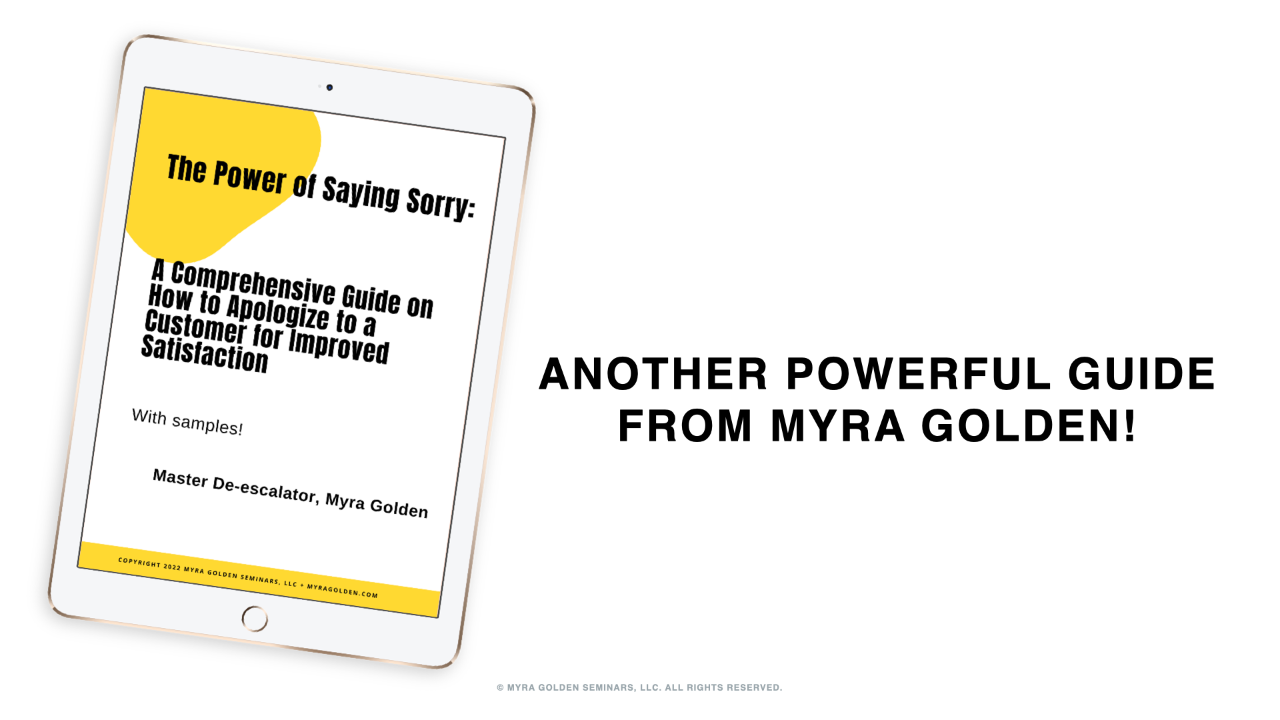The Power of Saying Sorry: A Comprehensive Guide on How to Apologize to a Customer for Improved Satisfaction

In today's competitive business landscape, customer satisfaction is the key to success. One of the most critical aspects of customer satisfaction is how businesses handle mistakes and apologize to their customers. Making errors is inevitable for any business, but how we react to those errors can make all the difference in retaining customers and maintaining a positive brand reputation.
Apologizing to a customer might seem like a simple task, but it is an art that requires careful thought and consideration. How you apologize can make or break the customer's perception of your brand. In some instances, a well-crafted apology can even turn a negative experience into a positive one, leaving the customer with an even more favorable impression of your business than before.
This comprehensive guide aims to provide you with the knowledge and tools necessary to master the art of apologizing to customers. We will explore the psychology behind a genuine apology, critical principles on how to apologize to a customer, sample approaches on how to apologize for bad service, tips and techniques for apologizing for long wait times, examples of how to apologize professionally in an email, and guidance on when not to apologize. By the end of this guide, you will be well-equipped to handle any customer service blunder with grace and professionalism.
The psychology behind a genuine apology
A genuine apology goes beyond simply saying, "I'm sorry." It involves acknowledging the mistake, taking responsibility for it, expressing empathy for the customer's feelings, and outlining steps to ensure it does not happen again. When done correctly, a genuine apology can help to rebuild trust, repair relationships, and demonstrate that your business cares about its customers.
To better understand the impact of a well-crafted apology, it's essential to delve into the psychology behind it. Research has shown that when people receive an apology, they feel a sense of validation and recognition of their emotional pain. This can lead to a reduction in negative emotions, such as anger and disappointment, and an increase in positive emotions, such as empathy and forgiveness.
Furthermore, studies have shown that when customers perceive an apology as sincere and meaningful, they are more likely to feel satisfied with the resolution of the issue, more likely to remain loyal to the brand, and more likely to recommend the business to others. In other words, a genuine apology can significantly impact customer satisfaction and brand reputation.
How to apologize to a customer: Key principles
When it comes to apologizing to a customer, there are several key principles to keep in mind:
- Be sincere: Customers can easily detect insincerity, so your apology must be genuine. This means acknowledging the mistake, taking responsibility for it, and expressing empathy for the customer's feelings.
- Be specific: Avoid making vague apologies. Instead, be clear about the issue and how it affected the customer. This demonstrates that you understand the customer's concerns and are taking them seriously.
- Offer a solution: A simple "I'm sorry" is not enough. Customers want to know you understand their concerns and are taking steps to prevent the issue from happening again. Offer a solution or explain how you will address the issue moving forward.
- Act quickly: When a customer has had a negative experience, it's important to apologize as soon as possible. This shows the customer that you value their business and are committed to resolving the issue.
- Follow up: After apologizing, follow up with the customer to ensure you've fully addressed their concerns and that they are satisfied with the resolution.
How to apologize for bad service: Sample approaches
When faced with a situation where you need to apologize to a customer for bad service, it's essential to choose the right approach based on the specific circumstances of the incident. Here are some sample approaches you can adapt to suit your needs:
- The direct approach: This approach involves directly acknowledging the issue, expressing empathy for the customer's feelings, and offering a solution. For example: "I'm very sorry you experienced such poor service during your visit. I understand how frustrating this must have been for you. We will provide additional training to our staff to ensure this does not happen again."
- The empathetic approach: This approach focuses on expressing empathy for the customer's feelings and offering support. For example: "I can only imagine how disappointing it must have been to receive such poor service. I want you to know that we take your concerns very seriously and will do everything possible to make things right."
- The proactive approach: This approach involves taking the initiative to address the issue before the customer even has a chance to complain. For example: "We've noticed that your order took an unusually long time to arrive, and we wanted to reach out and apologize for the inconvenience. We are currently investigating the cause of the delay and will ensure that it does not happen again."
How to apologize professionally in an email: Examples
When apologizing to a customer via email, it's essential to strike the right tone and follow the fundamental principles discussed earlier. Here are some examples of how to apologize professionally in an email:
- Example 1:
Subject Line: Our Apologies for the Inconvenience
Dear [Customer's Name],
I apologize for the issue you experienced with your recent purchase. We understand that the product you received needed to be better. This is different from our usual high-quality offerings.
We take full responsibility for the mistake and would like to offer you a full refund or replacement at no additional cost to you. Additionally, we will thoroughly review our quality control processes to prevent this from happening again.
Again, we sincerely apologize for any inconvenience this may have caused and appreciate your understanding. If you have any further questions or concerns, please do not hesitate to contact us.
Best regards,
[Your Name]
- Example 2:
Subject Line: Addressing Your Concerns
Dear [Customer's Name],
Thank you for bringing the issue with your recent order to our attention. We apologize for the inconvenience this has caused and understand the frustration you must be feeling.
After reviewing your order details, we shipped the incorrect item to you. We take full responsibility for this mistake and assure you we are working diligently to correct it. A replacement item will b to you immediately, and we will cover all associated costs.
We appreciate your patience and understanding as we work to resolve this issue. If you have any further questions or concerns, please get in touch with us.
Sincerely,
[Your Name]
Apologizing for long wait times: Tips and techniques
Long wait times can be a significant source of customer frustration, and addressing this issue promptly and professionally is essential. Here are some tips and techniques for apologizing for long wait times:
- Acknowledge the wait: Begin by acknowledging the customer's frustration and expressing empathy for their situation. This shows that you understand their concerns and are taking them seriously.
- Provide an explanation: Offer a brief explanation for the wait, if possible. This can help the customer understand the cause of the delay and may alleviate some of their frustration.
- Offer a solution: If applicable, provide a solution to help mitigate the inconvenience caused by the long wait time. This could include offering a discount, expediting the customer's order, or providing some other form of compensation.
- Reassure the customer: Reiterate your commitment to providing excellent customer service and assure the customer that you are working hard to address the issue and prevent it from happening again in the future.
How to say sorry in an email for a mistake: Crafting the perfect apology
When apologizing for a mistake in an email, it's important to follow the key principles of apologizing and consider the specific context of the situation. Here are some tips for crafting the perfect apology email for a mistake:
- Use a clear and concise subject line: Your subject line should accurately convey the purpose of the email and grab the customer's attention.
- Be sincere and empathetic: Express genuine remorse for the mistake and empathize with the customer's feelings.
- Take responsibility: Clearly acknowledge the error and take full responsibility for it.
- Offer a solution: Explain how you plan to address the issue and what steps will be taken to prevent it from happening again in the future.
- Close with appreciation: Express your gratitude for the customer's understanding and patience as you work to resolve the issue.
The impact of apologizing on customer satisfaction
A well-crafted apology can have a significant impact on customer satisfaction. When customers perceive an apology as sincere and meaningful, they are more likely to feel satisfied with the resolution of the issue, more likely to remain loyal to the brand, and more likely to recommend the business to others.
By mastering the art of apologizing to customers, you can turn negative experiences into opportunities to strengthen relationships and demonstrate your commitment to providing excellent customer service. In doing so, you can improve customer satisfaction and ultimately contribute to the success of your business.
When not to apologize: Avoiding over-apologizing
While apologizing is essential for any customer service professional, it's important to recognize that there are some situations where an apology may not be appropriate. Over-apologizing can weaken the impact of a genuine apology and may even come across as insincere.
Here are some situations where it may be best to avoid apologizing:
- When the issue is out of your control: If external factors outside your control caused the problem, such as a natural disaster or a supplier issue, apologizing may not be necessary. Instead, focus on providing clear communication and updates to the customer.
- When an apology could be seen as an admission of guilt: In situations where legal or regulatory issues are involved, an apology could be seen as an admission of guilt. In these cases, it's important to consult legal counsel before issuing statements.
- When it could create unrealistic expectations: Apologizing for minor issues or mistakes could set unrealistic expectations for customers, leading them to expect an apology for every inconvenience they experience.
- When the company is not responsible for the problem. You apologize when you're at fault. "I'm sorry" is ideal for conveying empathy when things have gone wrong, yet the company isn't responsible. I break down the sorry versus an apology in this video.
Conclusion: The power of saying sorry and moving forward
Apologizing to customers is essential for any business that wants to maintain a positive reputation and retain loyal customers. By following the fundamental principles of apologizing and using the tips and techniques outlined in this guide, you can handle mistakes gracefully and professionally, turning negative experiences into opportunities to strengthen relationships and improve customer satisfaction.
Remember, a well-crafted apology can significantly impact how customers perceive your brand. You can demonstrate your commitment to providing excellent customer service and building lasting customer relationships by acknowledging mistakes, taking responsibility, and offering solutions. So the next time you encounter a customer service blunder, remember the power of saying sorry and moving forward.
Continue the Conversation with Me?
With empathy and a smile, customer support teams must give bad news, deal with angry people, and de-escalate intense interactions. Your team - and you- deserve support, and it's my pleasure to serve YOU! Check out my Customer Service Master Class and De-escalation Academy for help with everyday and challenging interactions.
De-escalation Academy
The step-by-step, psychology-backed system that helps your team handle any tough customer interaction with calm, control, and confidence—on the phone, in person, or in chat.
Join Myra’s Inner Circle: Insights, Strategies, and Resources for Leaders Who Demand the Best.
Be the first to receive exclusive strategies, curated resources, and behind-the-scenes insights from Myra Golden—crafted for leaders who value excellence.
Your information will remain private and protected—always.

